White dress shirts are, of course, a foundational item in a classic men’s wardrobe. But if you own one or more white shirts, you’ve probably experienced the difficulty of keeping them, well, white. In this installment in our ongoing stain series, and in it we’ll describe why shirts discolor, how you can get this discoloration out, and how to prevent discoloration in the first place.
This guide is not about cleaning more general stains out of white shirts, like wine spilled during dinner, ink from a leaky fountain pen, or blood following an altercation with Raphael. To remove these kinds of stains from your white shirts or from any other clothes, consult our guide on removing all different types of stains.
How to Remove Stains from Any Garment
Why Do White Shirts Discolor?
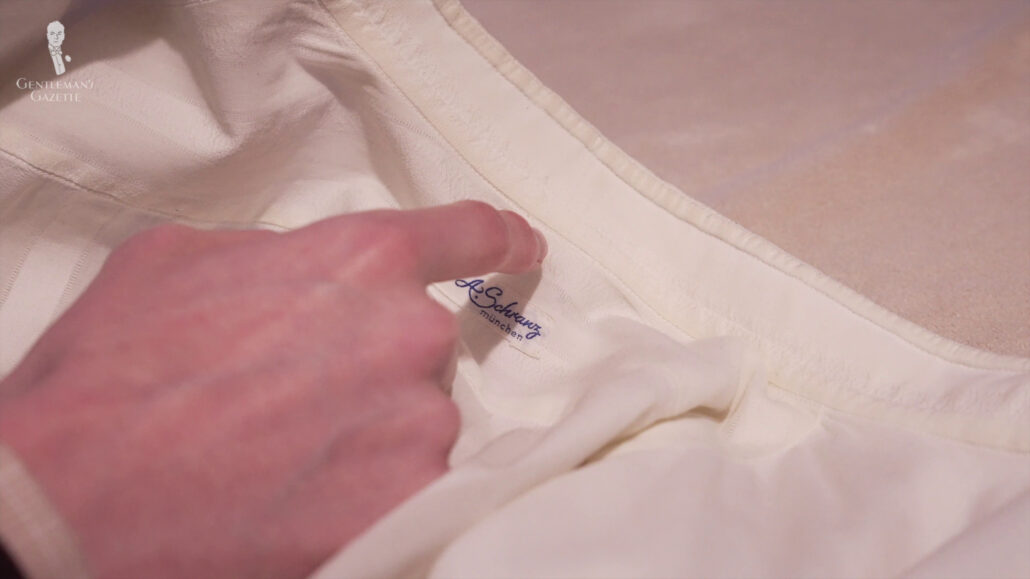
In order to better understand how to prevent the discoloration of white shirts, we should talk about why they discolor in the first place.
Discoloration on white shirts can assume a few different forms, from a general gray or yellowish cast across the whole shirt to yellowing in more specific or localized areas. In both cases, the main culprits are body oils and sweat that settle into a shirt’s fabric and become stains over time.
Unsurprisingly, then, this discoloration is most commonly found on problem areas on shirts where oil and sweat tend to collect. These include, but aren’t limited to the underarms; the collar, especially at the back of the neck; the cuffs; and, occasionally, the hem.
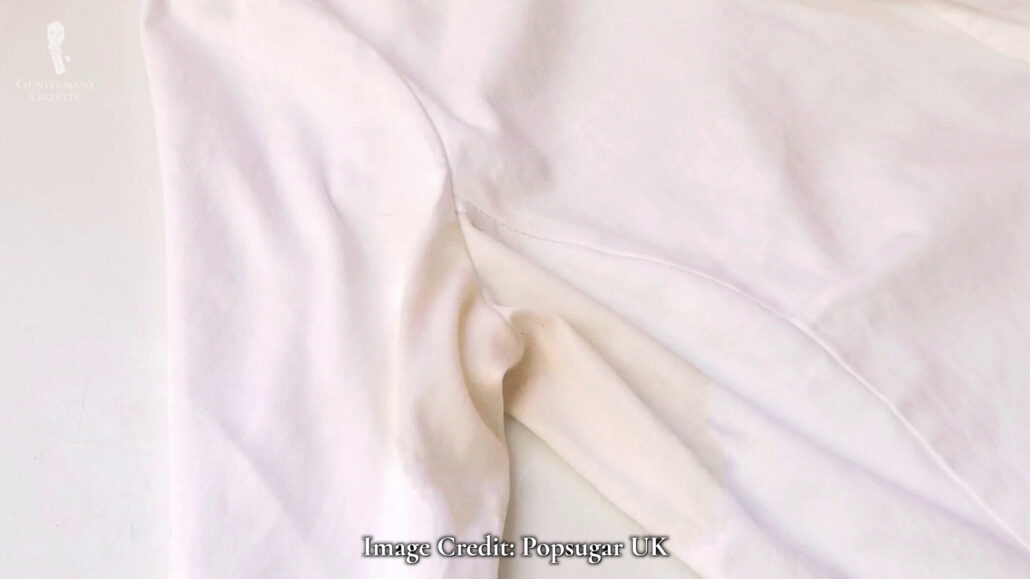
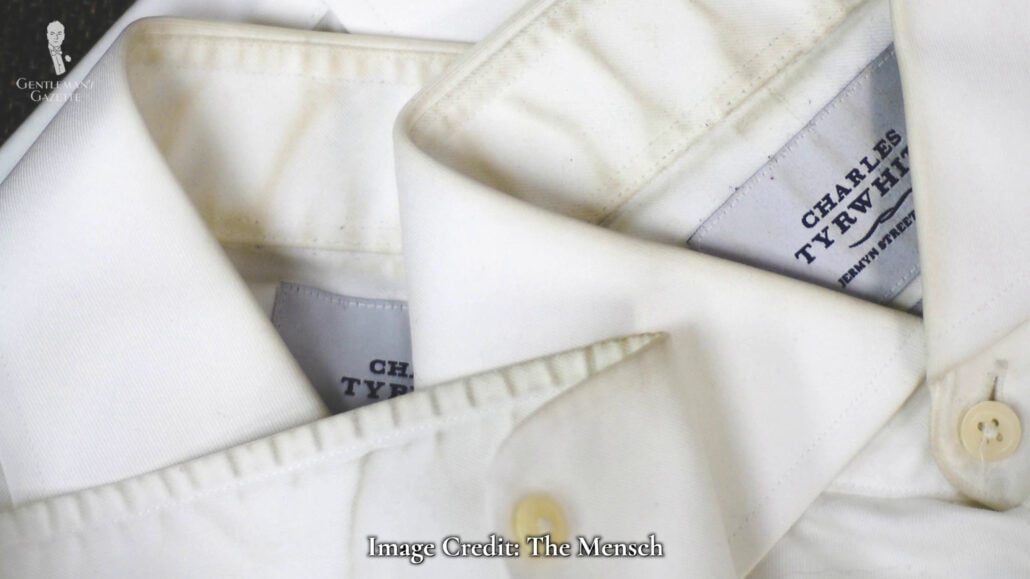
Discoloration can also come from the chemicals and minerals that are ingredients in many personal care products. One commonly cited culprit here would be aluminum found in many antiperspirants. Very minor or invisible stains or small particles can also lead to bigger stains on white shirts over time. This mainly occurs if said stains or particles are left to oxidize on the fabric. You might have noticed this before if you’ve put what you thought was a clean white shirt into storage only to bring it out months later to find it yellow or dingy. And of course, all stains, no matter their source, tend to be more visible on white shirts than any other because the shirt’s lack of color means that other colors are going to show up more readily.
We should also note here that no natural fabric is naturally white; rather, whiteness can only be achieved through dying or bleaching. Even untreated cotton is naturally off-white in color. Therefore, white shirts are, in some ways, defying the laws of nature, so it’s no surprise that they’re a struggle to keep completely clean.

But, we’ve never met a clothing problem we couldn’t handle, so here are our tips on how you can keep defying nature and keeping your white shirts white. And as always, before attempting any of the treatments we’re going to suggest today, you should spot check them on a hidden area of the garment to ensure that no adverse reactions occur. After all, we don’t want the shirts to look worse than when we started.
Learn the intricacies of Winter White
Removing Localized Stains
First, we’re going to cover how to remove localized discoloration in the areas we mentioned earlier, like the cuffs or underarms. For more general discoloration, you can skip to the next section by using the chapter functions below.
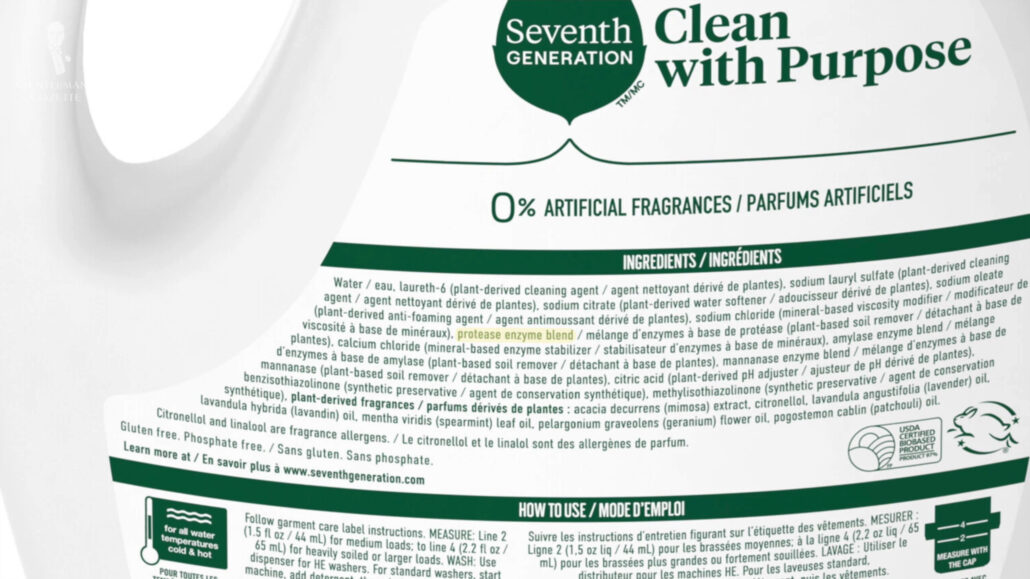
We’ll begin here by applying a cleaning or whitening product to the stain. You can use specialized products like The Laundress Wash & Stain Bar or OxiClean Stain Remover, or diluted liquid or powder detergent mixed with water. In particular, look for products with an enzyme-rich formula, as they’re going to be good at breaking down the fats, oils, and proteins that make up many stains.
If you prefer a more homemade approach, you can make a cleaning paste using ingredients like baking soda, vinegar, hydrogen peroxide, and water.
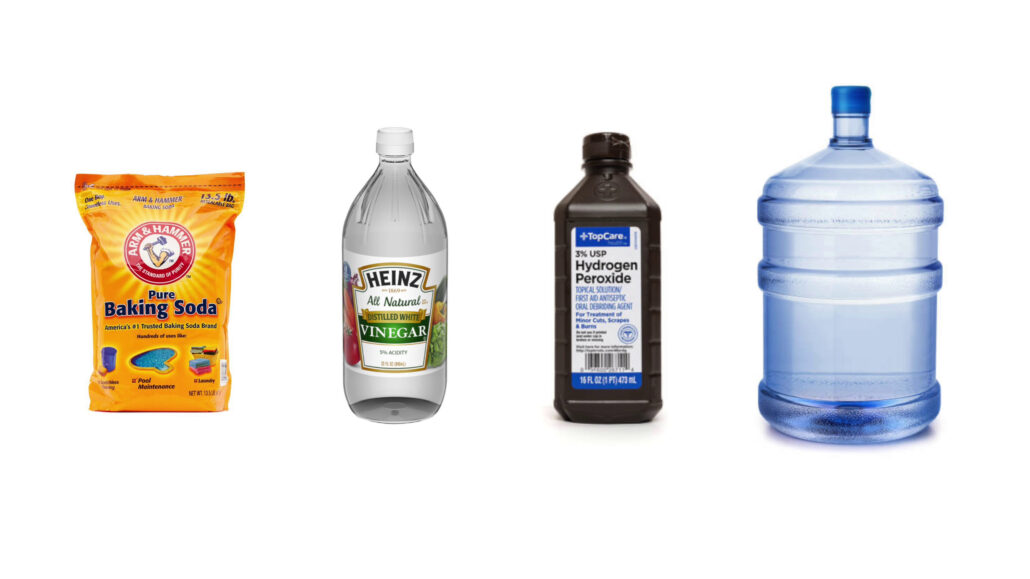
For particularly tough stains or stains that are old and thoroughly set, you can also use a bleach alternative, which has many of the cleaning and whitening properties of chlorine bleach, but won’t seriously damage most fabrics. That being said, you should still always be careful even with bleach alternatives and follow the instructions on the package.
Start by working your chosen product gently into the stained fabric with a sponge or a small brush, then allow it to sit for at least 30 minutes or for several hours for tough or set stains. Alternatively, you can also soak the discolored shirt with the product in water, provided that doing so is in keeping with the shirt’s garment care instructions and the washing instructions of the cleaning product. Then, gently rinse the treatment out of the shirt with water.
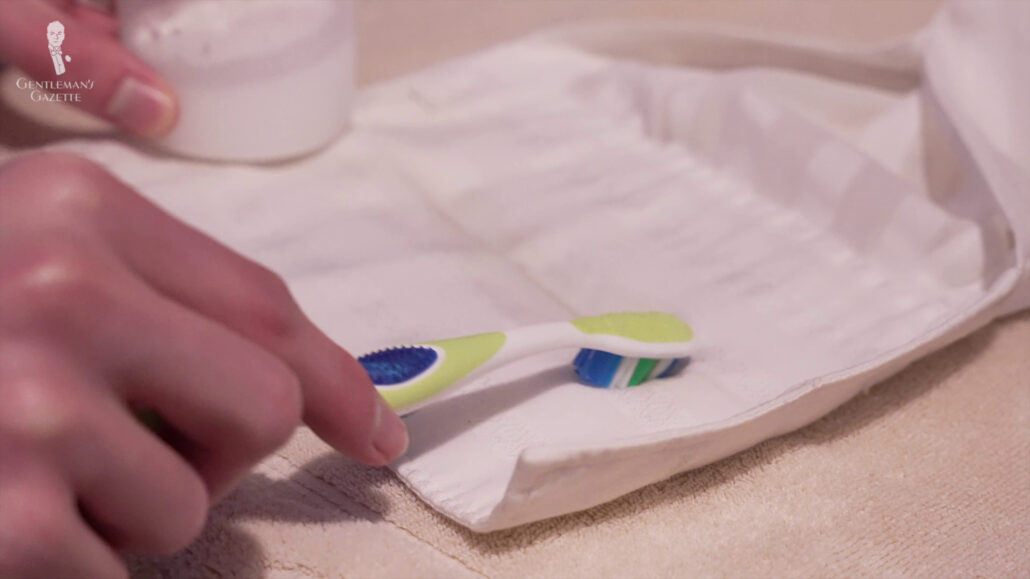
If the stain is gone, great. We recommend giving the shirt one more standard wash to remove any lingering odors or product, and then treating yourself to some brandy or ice cream for a job well done. If the discoloration persists, but it’s less intense, then try the entire process another time.
If the discoloration still persists, then we recommend taking your white shirt to a trusted local dry cleaner. After all, they are professionals, and they have more than a few tricks and special products up their sleeves. And your last recourse here should be chlorine bleach. It’s almost always going to bleach the stain white, but it’s also often going to damage the fabric in the process. So, use chlorine bleach only with extreme caution and always follow the instructions on the package.
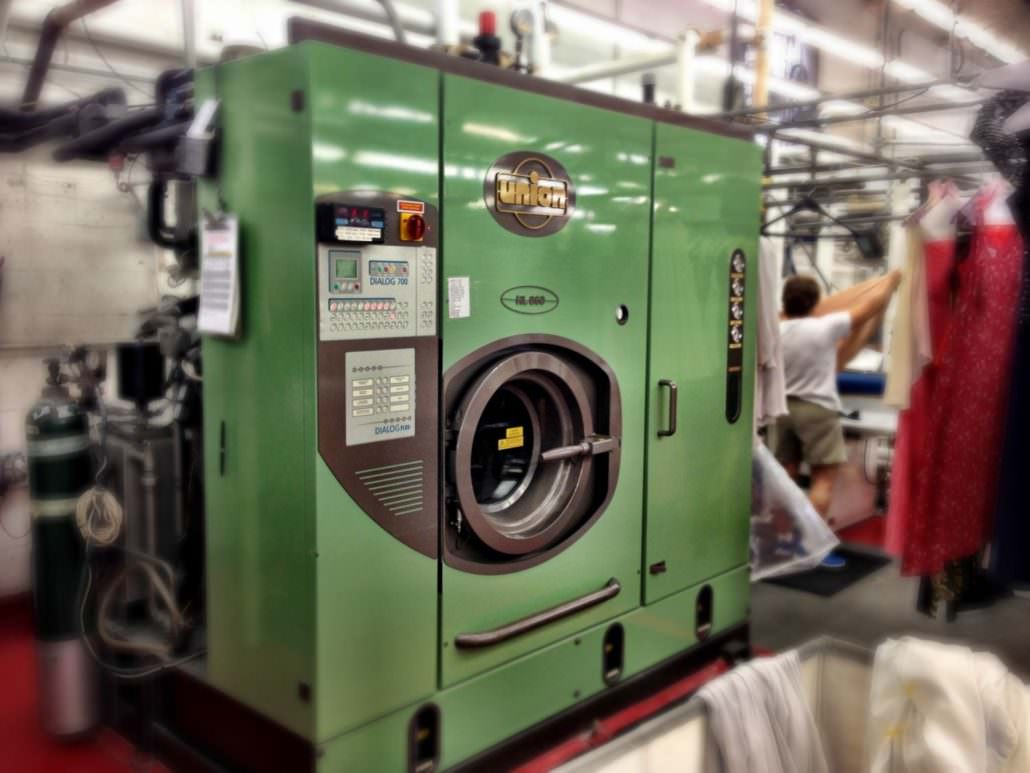
Removing General Discoloration
Next up today, let’s cover situations in which the entire shirt seems to be generally discolored. This sometimes happens with older and well-worn shirts, but you can remove the yucky yellow or grimy gray with a revitalizing wash. Essentially, you’re going to soak the shirt in cleaning agents that will lift away the stains and restore the shirt’s whiteness.
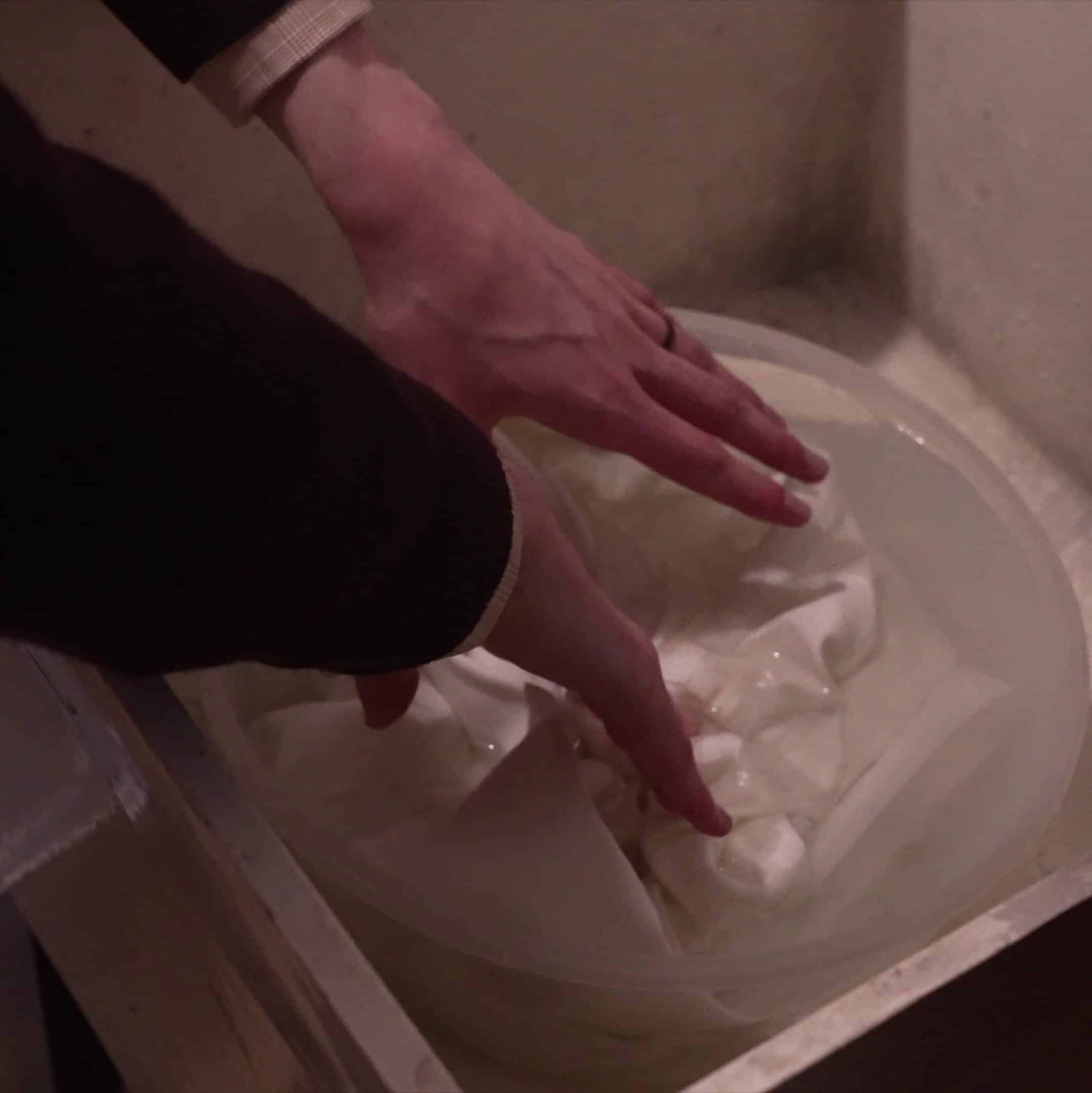
The simplest way to do this is to soak your shirt in a sink filled with hot or warm water, depending on the shirt’s garment care instructions, and then add your cleaning agent according to its own instructions.
One of the easiest cleaning products to use will be a detergent specifically formulated for white fabrics as it will contain unique agents like low concentrations of bleach alternative to help brighten and clean white fabrics. These would include OxiClean White Revive Whitener, Out White Bright, Tide Plus Bleach Alternative, and Laundress All-purpose Bleach Alternative. All of these are common options.
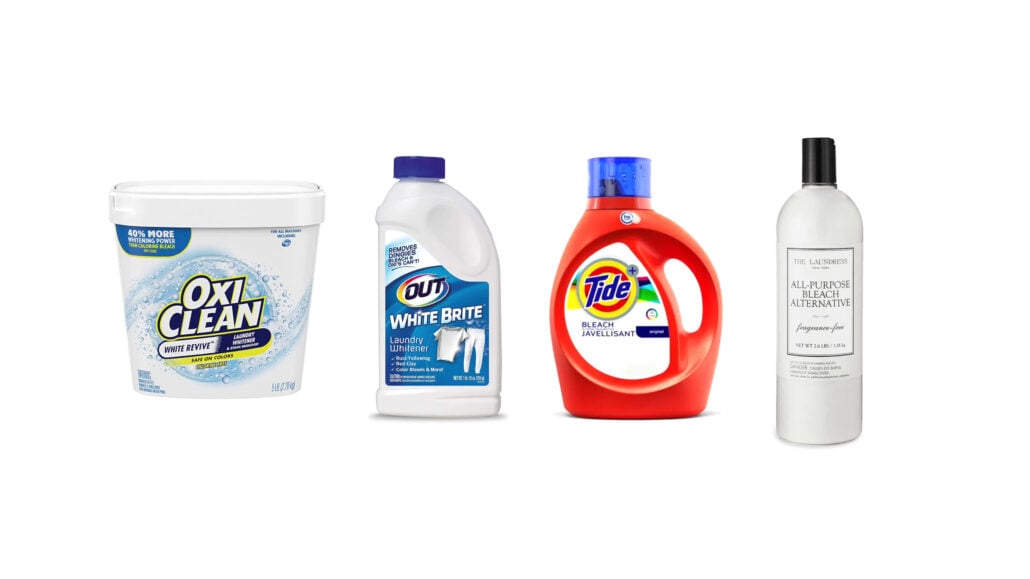
By the way, this post is not sponsored. And if you prefer a homemade alternative, you can also use about two cups of baking soda.
Whatever you’re using, let your shirt soak in this solution for a few hours, and then wash as normal. If the discoloration persists, then you can move on to more specialized products. The first of these is bluing, which is a blue dye that is added in small amounts to many white fabrics. This is because a subtle blue tinge in white fabrics is actually perceived in most lights as being whiter than white. Just like Dr. Niles Crane’s parrot, Baby.
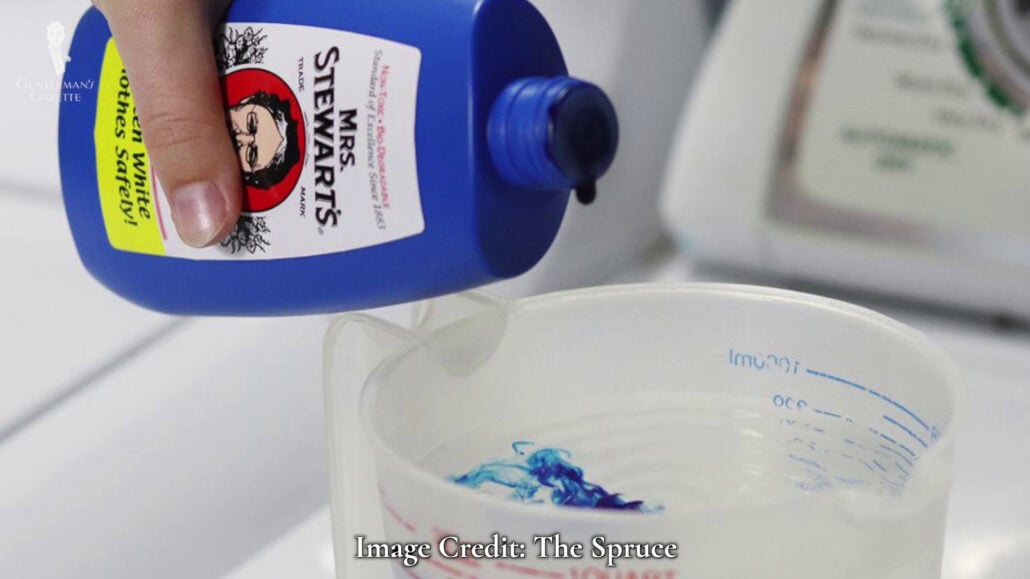
Many white shirts are actually sold blued, but the bluing eventually washes out. So, adding back in some additional bluing can trick the eye into seeing even discolored shirts as being whiter than they really are.
A common brand to use here would be Mrs. Stewart’s Concentrated Liquid Bluing. Here, we’ll just tell you to follow the instructions on the package to use it.
And if general discoloration still persists, it might again be time to seek out help from your local dry cleaner or use chlorine bleach. But, again, only do this ladder option while exercising extreme caution.
Quick Tips to Prevent Discoloration
So, now that we’ve covered how to restore the whiteness to your white shirt. Let’s quickly cover twenty tips for how to keep them white.
1. Wear an undershirt.

Our first tip is fairly simple: wear an undershirt. After all, the more sweat and body oils absorbed by your undershirts, the less there will be to stain your dress shirts.
2. Don’t forget to scrub your neck.

When bathing, it’s easy to forget to scrub the back of your neck, but as discussed earlier, that is an area where body oils and sweat can accumulate. So, do remember to clean your neck when you’re in the shower.
3. Don’t apply personal products directly onto fabrics.
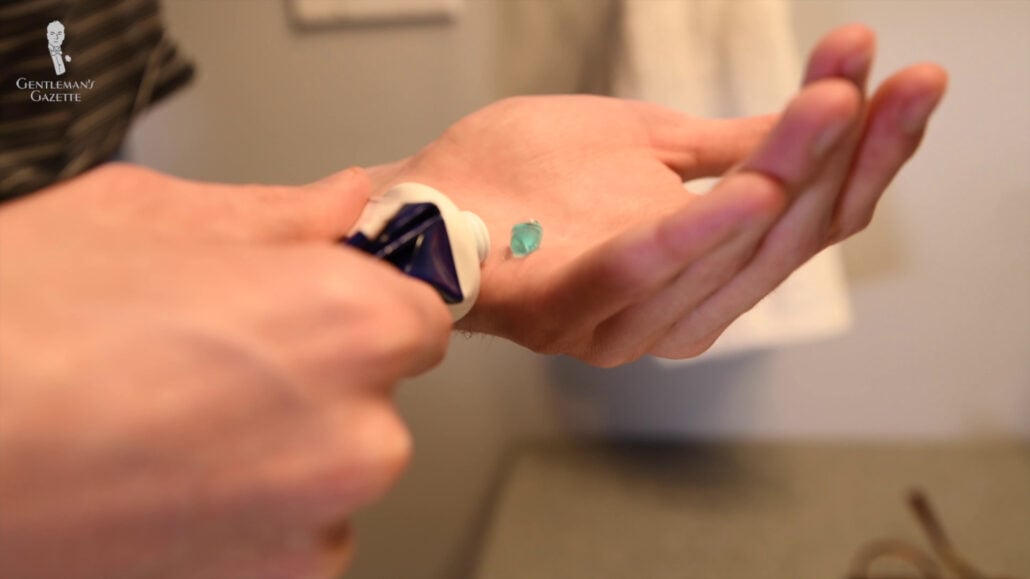
Allow liquid products to dry completely before putting on your white shirts. This means things like sunscreen, lotion, fragrances, hair products, and other toiletries need to dry completely before you put your shirt on.
And while we’re on the subject of personal products, we’ve already alluded to the fact that aluminum can react with your body chemistry to produce more pronounced stains on your underarms.
To reduce this issue, you can switch to non-aluminum antiperspirants or non-antiperspirant deodorants altogether. But, sweat and oils from your body can still stain your shirts, so doing this might not completely resolve the issue in all cases.
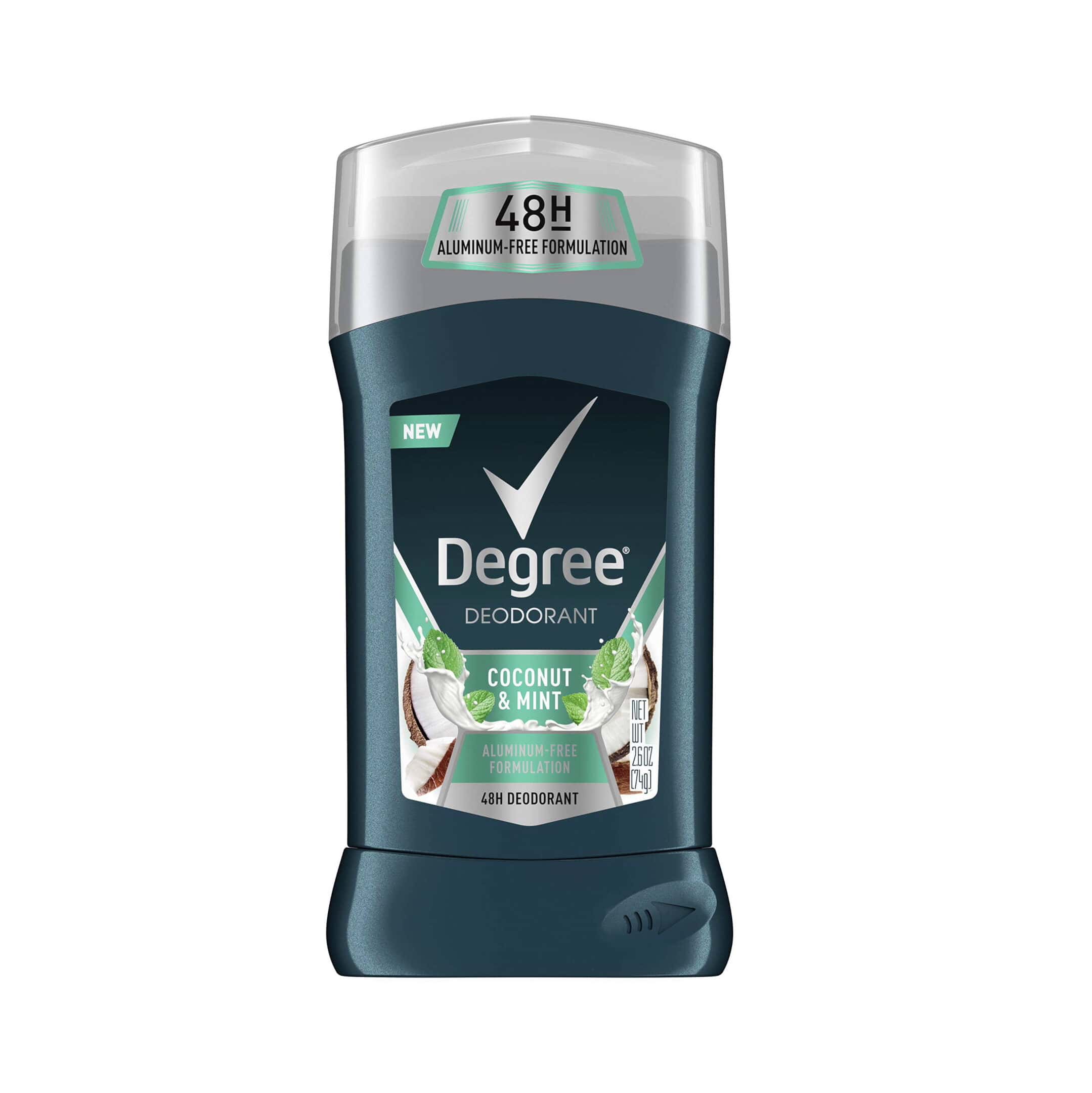
Speaking just for myself, since switching a few years ago to aluminum-free, non-antiperspirant deodorant. The yellowing on my shirts’ underarms has thankfully stopped.
4. Spritz shirts with lemon juice before wearing them.
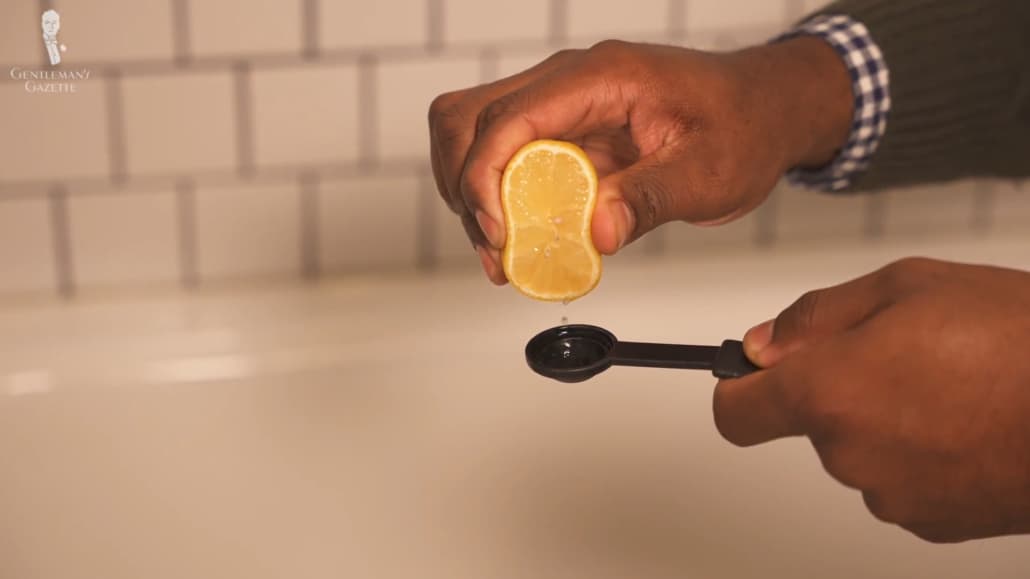
A lemon drop makes sweat stains stop. Lemon juice naturally counteracts these staining effects of body oils and sweat, so spritzing your shirts with lemon juice before putting them on can counteract staining. By the way, this trick was one of many life hacks we identified for the modern gentleman, and if you want to see the rest of the list, you can find that in our other guide.
35 Life Hacks For The Modern Gentleman
5. Pretreat shirts after wearing.
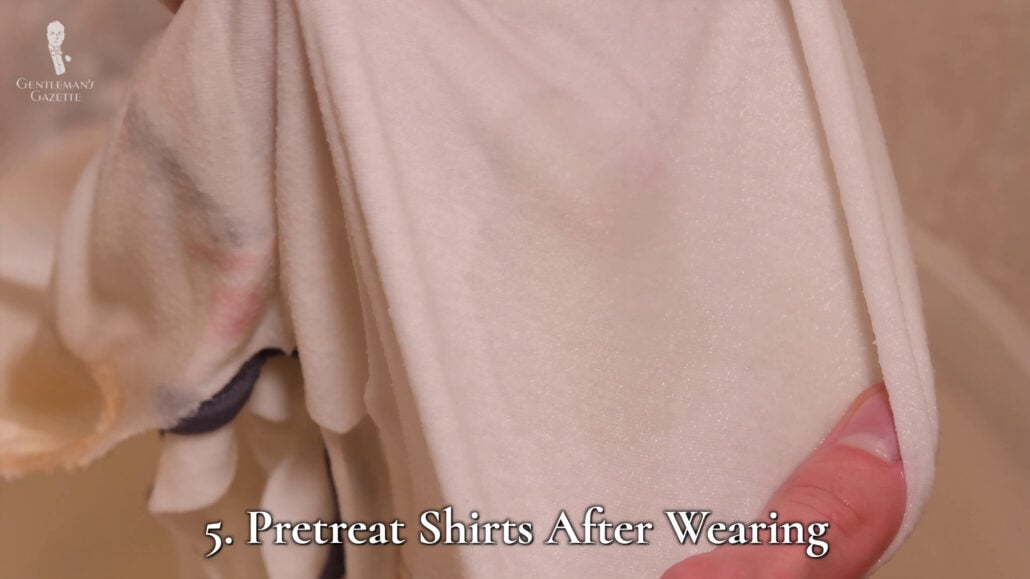
Before completely washing your non-dry, clean-only white shirts, wash out the problem areas, like the underarms and cuffs, with a little bit of water. This will help to prevent body oils and sweat from setting in until laundry day.
6. Wash white shirts more regularly.
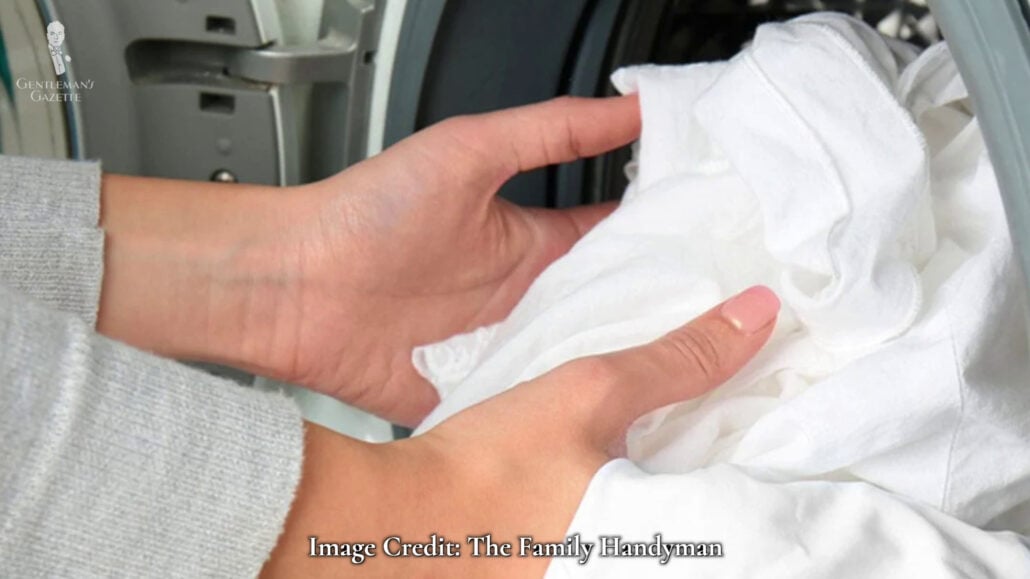
Again, to prevent sweat and oils from setting in, consider washing your shirts more frequently – after every two wears or even after every wear.
Again, speaking for myself, as someone with hyperhidrosis, I routinely wash all of my garments, basically after every wear, and I find that this does help to prevent some staining.
7. Quickly handle any stains.
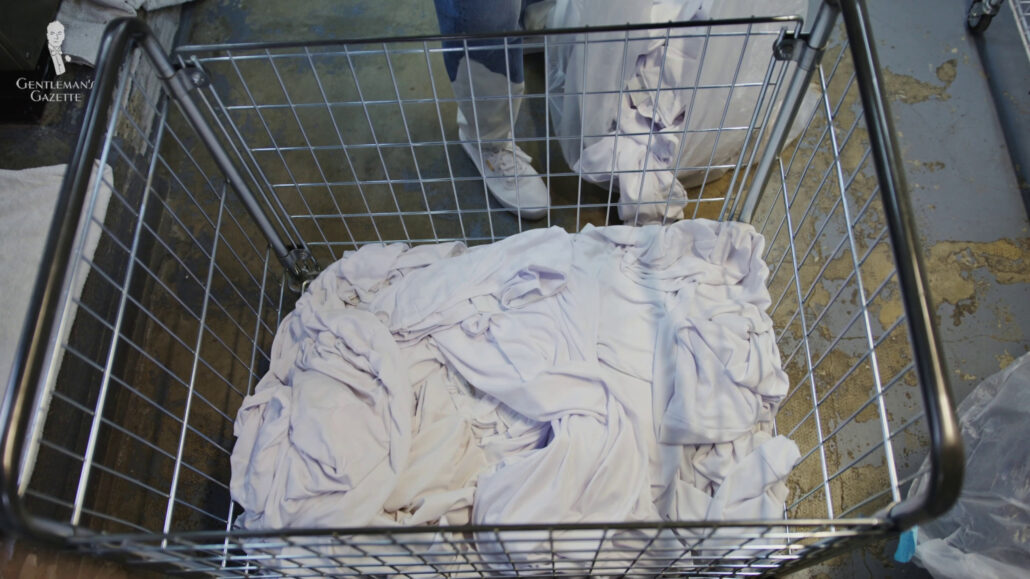
Stop stains speedily. Fast action is key to removing any stain, but it’s especially important with white shirts. So, when stains do occur, make sure to treat them as soon as you notice them.
8. Pretreat before washing.
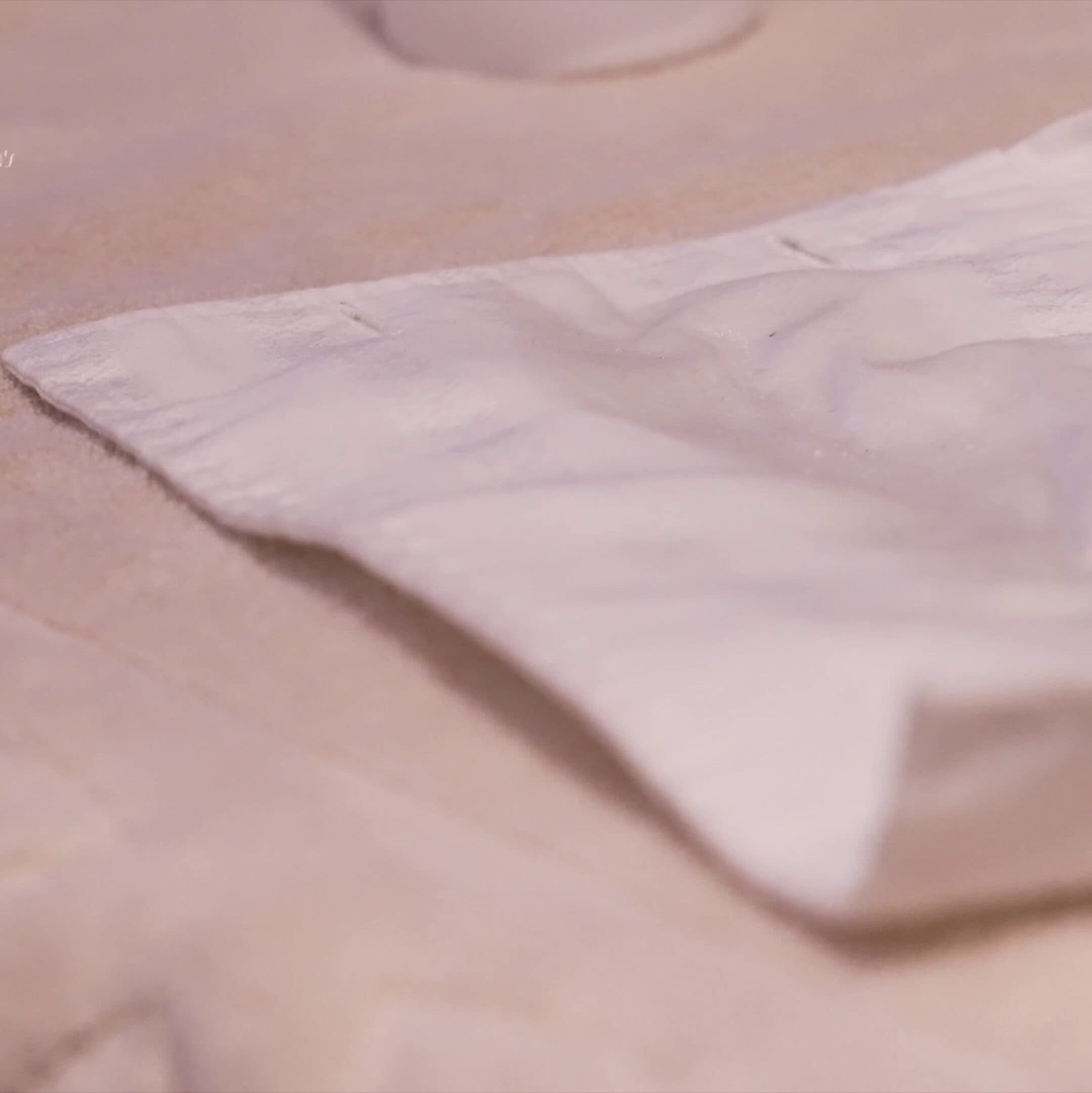
Pretreating is a treat. Apply a dusting of cleaning powder or liquid detergent directly to the problem areas of your shirts and let them sit for a while before putting them in the wash. This ensures that the cleaning agents will react directly and immediately to these problem areas.
By the way, you should also check the website of your shirts’ manufacturer as they will sometimes have tips for how to clean the shirt, including spot treatment.
9. Wash shirts inside out.
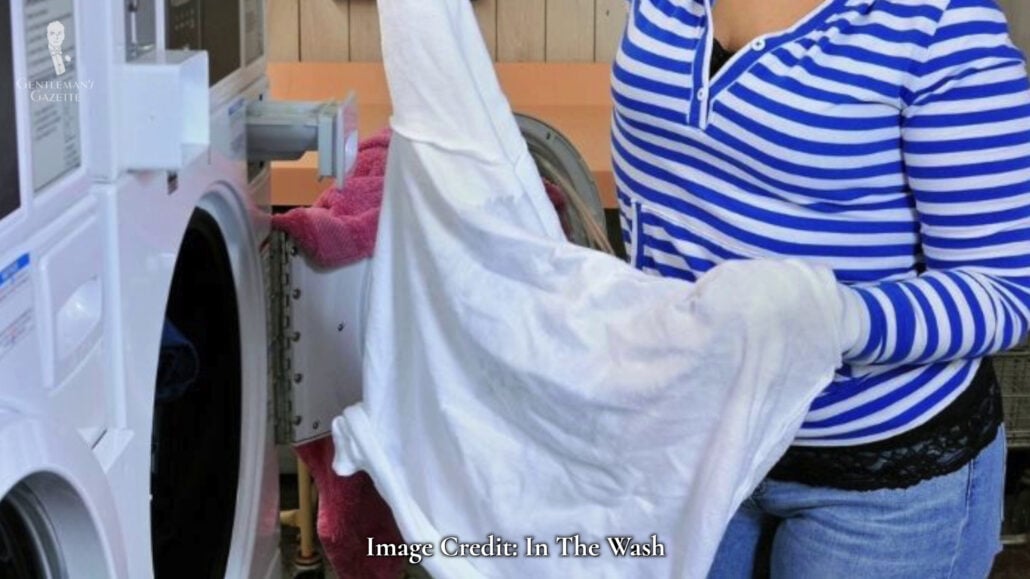
We’re all about inside out. The agitation of washing machines can damage some shirt fabrics and, as a consequence, this might make them look more gray. Therefore, turning your shirts inside out before you wash them can help prevent this.
10. Wash whites separately.
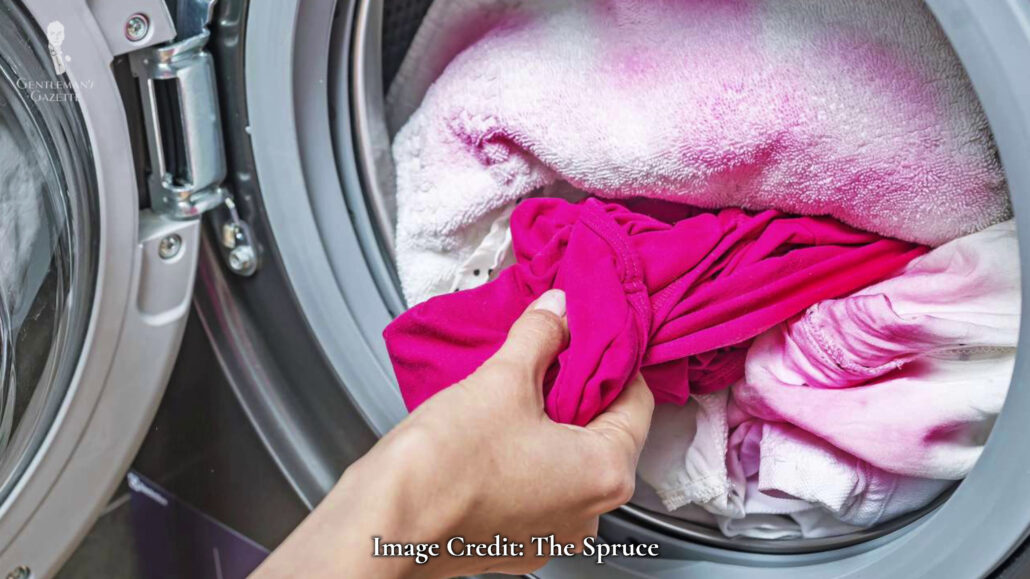
Separate and succeed. You are probably already aware of this, but, when doing laundry, it helps to separate your white fabrics from other fabrics that contain color. Not only will this help to prevent any dye transfer, but it will also allow you to dial in your settings for those that are especially good for white fabrics in particular.
11. Use a detergent formulated for whites.
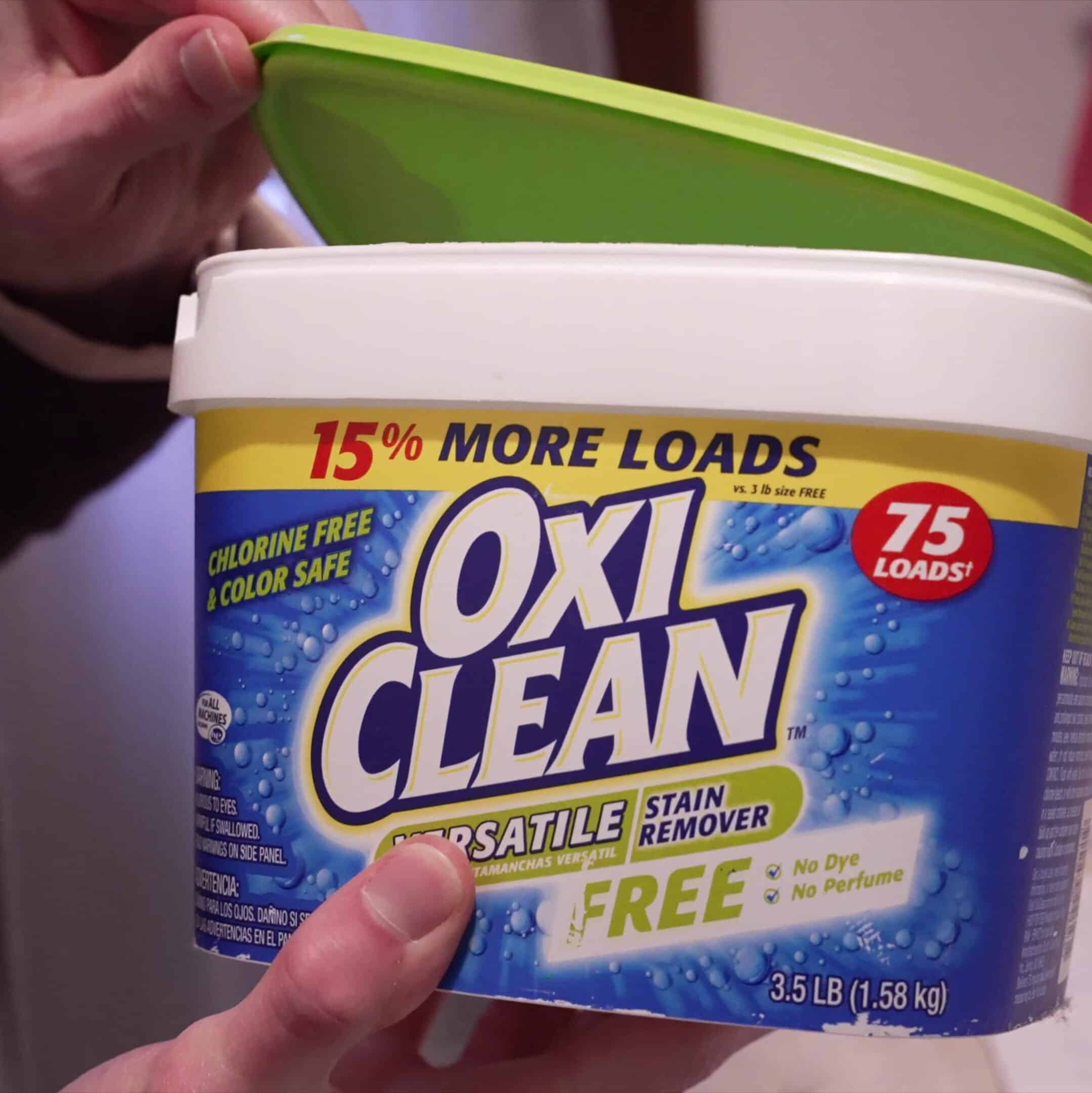
Find a fantastic formulation. The detergents we mentioned earlier that are good for soaking whites can also be good for washing whites. So, you can use some of them as detergent boosters and add them to your regular wash cycle as well.
12. Use the right amount of detergent.
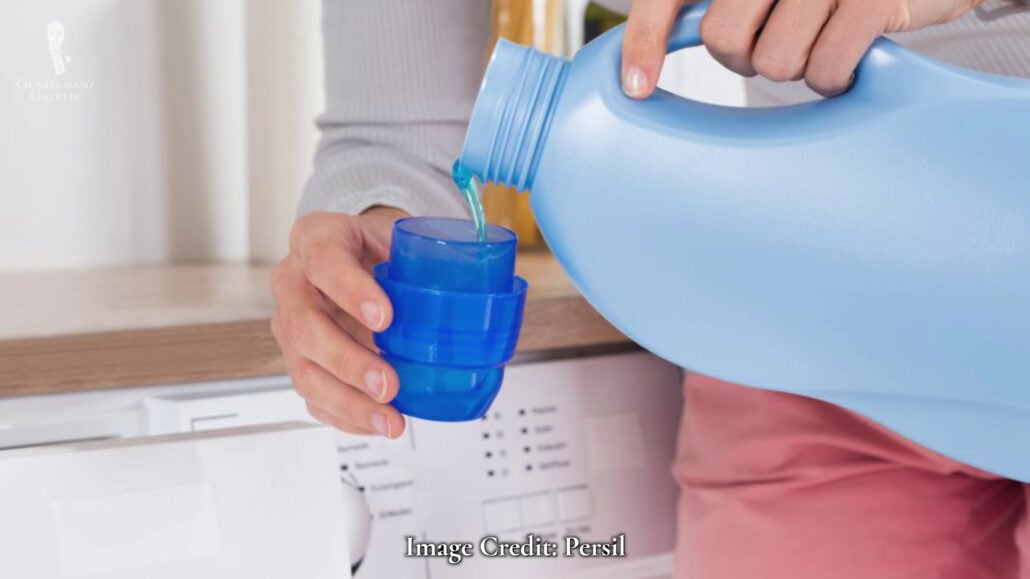
Determine detergent diligently. Insufficient detergent in laundry won’t remove stains properly and will allow them to settle in. But, conversely, using too much detergent can also have the side effect of making your shirts appear dingy and gray over time. This is because the excess detergent, which often contains petroleum, can settle into the fabrics over time. So, be sure to measure out your detergent with every wash because, as the old saying goes, “the right measurement ensures merriment.”
13. Avoid fabric softeners.
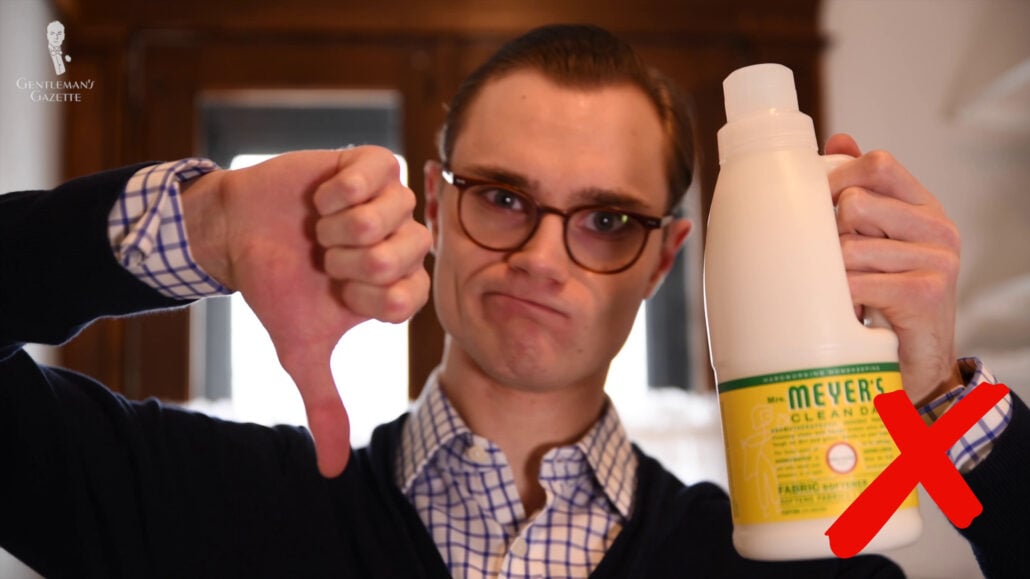
Many fabric softeners leave behind a residue that is especially noticeable on white shirts and can make them look dull. This is just one of the multiple reasons why it’s probably best to skip fabric softener entirely for your laundry routine.
By the way, we’ve also mentioned why this is a good idea in other installments of our laundry and garment care series, and if you want to take a look at the full playlist, you can find it here.
14. Consider an Extra Rinse Cycle.
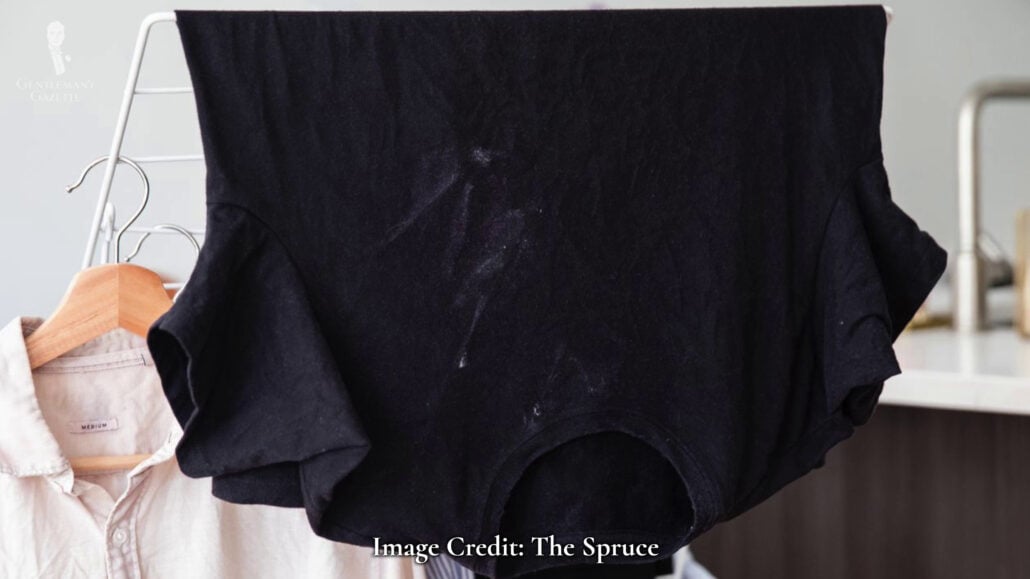
Rinsing twice can be nice. If you do find that you’re properly measured out cleaning products aren’t being removed during your normal wash cycle, consider adding another rinse to the cycle just to make sure that all of the product is removed.
15. Wash in sufficiently hot water.
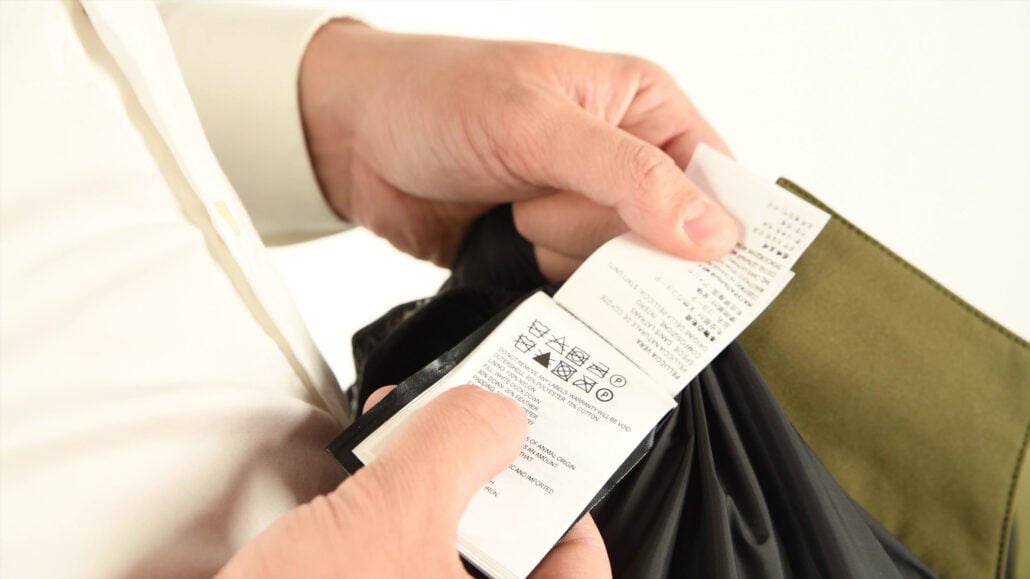
Remember to always follow garment care instructions so as not to wash shirts in excessively hot water, which can shrink or otherwise damage them. But, barring this, the hotter the water, the better, as it will more easily release stains from fabric.
16. Don’t overload the washer.
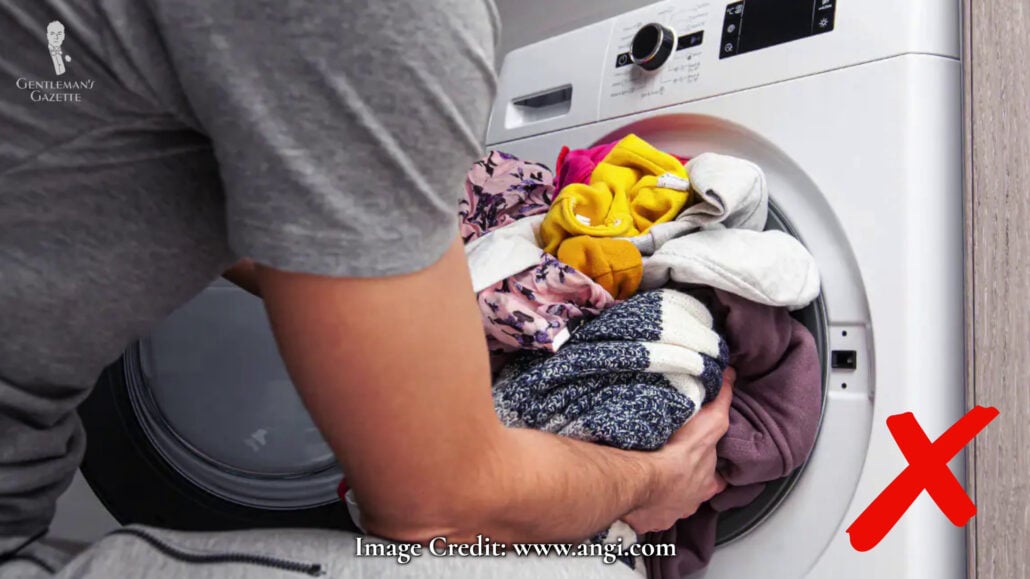
Don’t go overboard and overload. A properly balanced washing machine is going to more easily soak, agitate, and rinse your garments, so just don’t stuff it too full.
17. Clean your washer.
If the inside of your washing machine has become dirty from regular use, it’s probably going to leave your white shirts dirty, too.
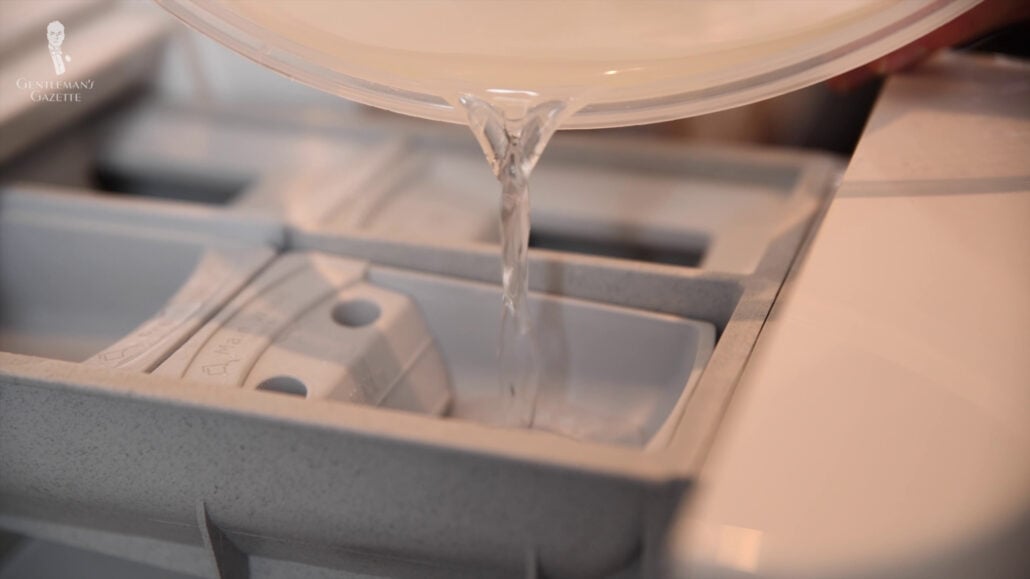
Like any appliance, a washer also requires regular cleaning, so follow your manufacturer’s instructions, or you can follow the advice that we provide in our cheap and easy laundry hacks post.
Cheap and Easy Laundry Hacks
18. Dry on the gentle cycle or in the sun.
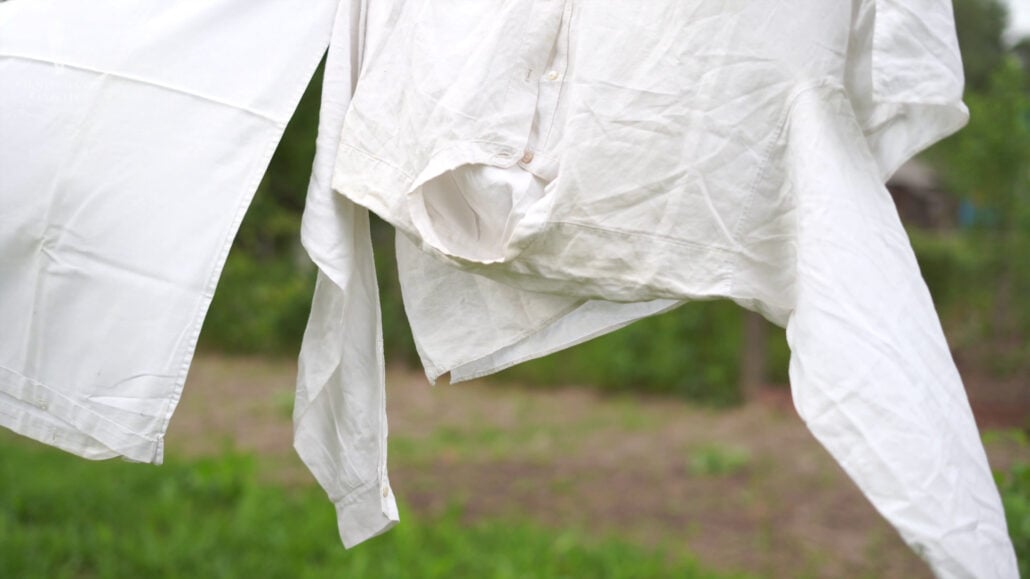
Dryers can bruise white shirts, so put your dryer on the gentle setting while you’re drying them or, better yet, only leave your shirts in the dryer for a few minutes to knock out the large wrinkle, and then hang dry them to finish. And if you hang dry in the sun, you could also take advantage of the bleaching effects of UV light. This is a phenomenon that’s probably, unfortunately, already known to those of you who have outdoor patio furniture. But, here, it will help you, not hurt you.
19. Be aware of hard water.
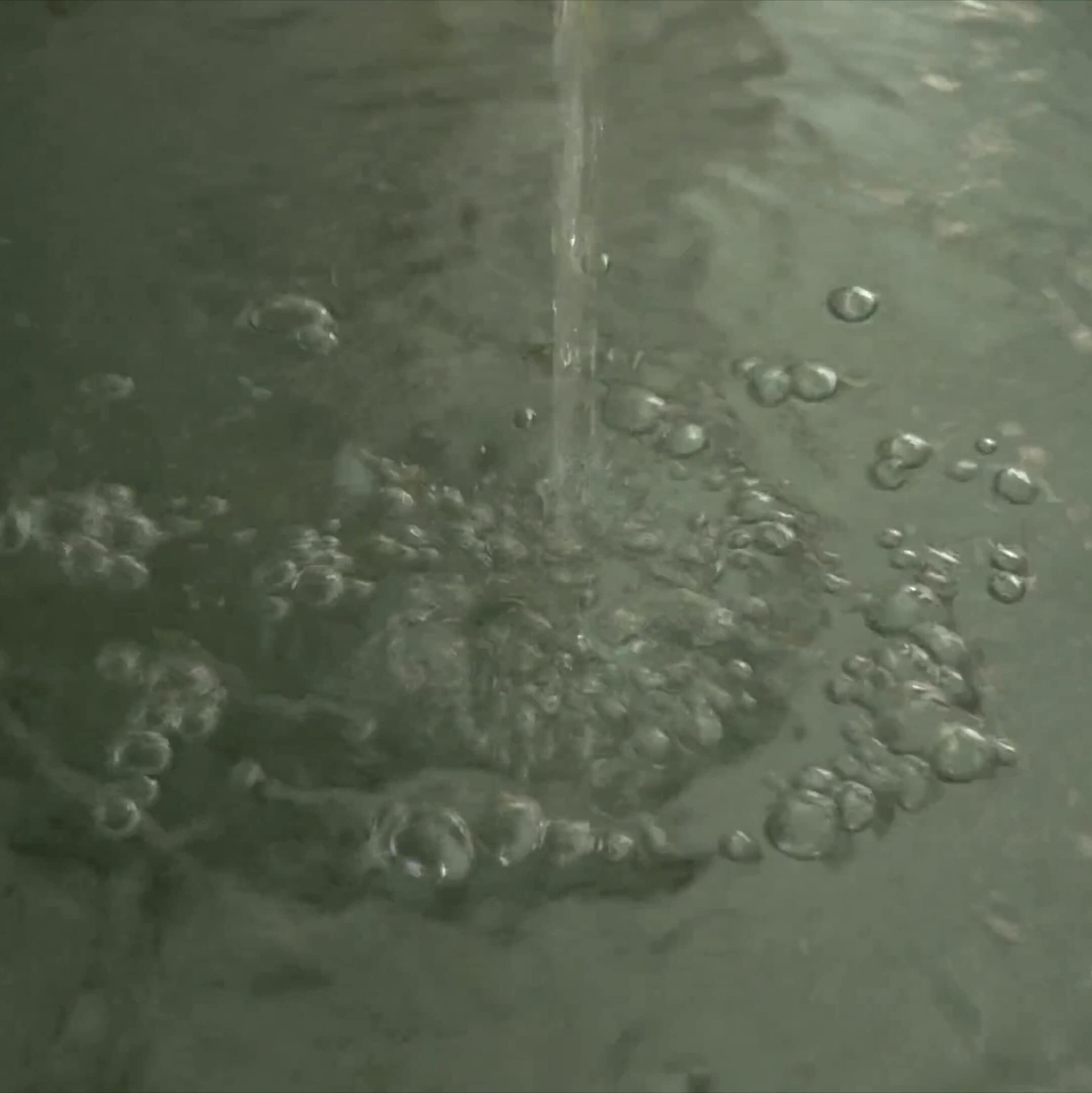
The minerals found in hard water can make white shirts appear dull, so if you know that this is happening to you and the water in your area is hard – usually indicated by crystals forming on taps or shower heads – consider using detergents that counteract the effects of hard water or even having a water softening device attached to your water line.
20. Store white shirts properly.

If you’re putting clothes into seasonal storage or putting away garments that you might not wear often, like a Black Tie or White Tie evening shirt, avoid clingy plastics that restrict airflow as these conditions exacerbate the chemical forces that create stains in stored clothes. Instead, opt for natural linen or cotton garment bags or plastic bags with panels for airflow. And for especially valuable items, consider using archival storage boxes and acid-free white tissue paper for the best results.
Conclusion
We hope you enjoyed learning about how to restore the whiteness to your white shirts and how to keep them white into the future.
Do you have any other whitening tips and tricks that we might have missed? If so, share them in the comments below.
Outfit Rundown
Today, I’m wearing a casual outfit, good for doing some garment care around the house. The central element is my wine-colored cardigan sweater from Charles Tyrwhitt, and I’m wearing it over a shirt in a terracotta color from Proper Cloth. The shirt features a glen check pattern, and while it does have French cuffs, I’ve got them configured in a barrel style with simple black links to fit better under the sweater sleeves.
My corduroy trousers from Cordings are in a traditional khaki color that harmonizes well with my shirt, and my shoes, which are from Crown Northampton, are cordovan leather sneakers. The dark reddish brown of the cordovan harmonizes well with my sweater, and the brownish tone in the gum soles goes well with my shirt and trousers.
To keep up this casual feel, I’ve also left product out of my hair and let my beard grow a bit. And rounding out today’s outfit are my two-tone solid socks from Fort Belvedere in burgundy and white that, again, go well with my sweater.
You can find the socks that I’m wearing today, along with a wide array of other classic men’s accessories, by visiting the Fort Belvedere shop.


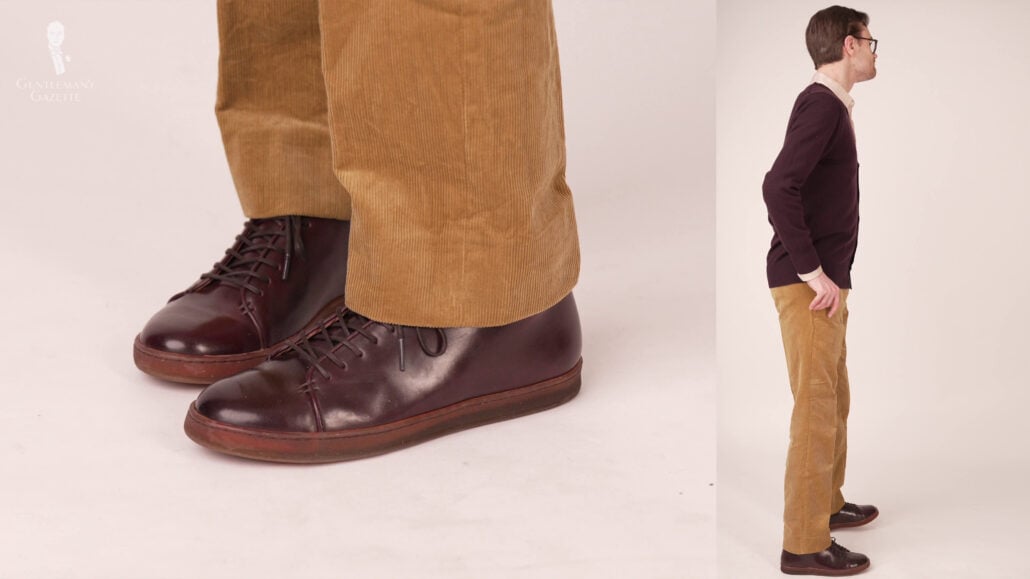
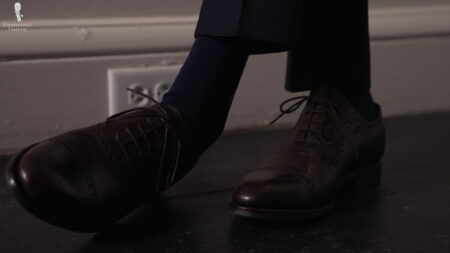
Well, good information as always. Interestingly have tried almost everything(including 10 crushed dissolved aspirin treatments). Nothing has completely whitened the neck rings. Dry cleaning is an expensive failure. Sets the stains permanently!. Found a perfect solution years ago. My 3 local GoodWills always have, as new quality, cotton white dress shirts on the racks for $6.99. A quick trip in their shirt isle has yielded dozens of shirts. It should be noted that I have extremely oily skin neck up plus very hard water for washing. I always wipe down my neck area with 80% alcohol before wearing any collared shirt but it only helps a little bit, unfortunately.
If you truly want dress shirts–and particularly white shirts–to appear their best, ALWAYS use a good shirt laundry that specializes in dress shirts. We are not in the “big city” and we have one cleaner that has developed a reputation for that. Some inquiry among your friends and acquaintances should put you onto right one straightaway.
I have not done a dress shirt myself since I was a sophomore in college, and that was some years ago. The “no iron, no press” description is a myth.
And always wear T-shirt! And shower before your dress!
Greetings,
Many thanks for the excellent advice for colleagues who are in a position to apply all of the cleaning products detailed herein.
In the 1980’s, when books regarding men’s fashion were first in print, I recall reading that a professional fella should buy a few high-quality white dress shirts, have them commercially laundered, and let ’em go after one year of regular wear.
Professionally laundering three shirts costs less than three basic cups of Starbucks coffee.
In so doing, a guy can wear a reliably clean dress shirt without spending excessively, save time by not attending to the particulars involved in washing work clothing , and save money by not having to purchase all of the specialized washing products detailed in the article above.
Best wishes for every success.
Sincerely,
Andrew Gregg,
Palm Springs, California.